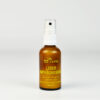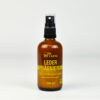Fragen und Antworten
PFAS- was ist das eigentlich?
PFAS von Tapir nicht eingesetzt - aber was bedeutet es in der Schuhpflegebranche - wir Klären auf
Häufig gestellte Fragen zu PFAS
Was sind PFAS?
PFAS steht als Abkürzung für per- und polyfluorierte Chemikalien. Diese Stoffgruppe umfasst nach letzten Schätzungen des Bundesministeriums für Umwelt, Naturschutz, nukleare Sicherheit und Verbraucherschutz (BMUV) mehr als 10.000 verschiedene Stoffe. PFAS kommen nicht natürlich in der Umwelt vor und werden erst seit den späten 1940ern hergestellt und eingesetzt.
Chemisch betrachtet bestehen die organischen Verbindungen aus Kohlenstoffketten verschiedener Längen, bei denen die Wasserstoffatome vollständig (perfluoriert) oder teilweise (polyfluoriert) durch Fluoratome ersetzt sind. Am häufigsten werden perfluorierte Carbon- und Sulfonsäuren sowie deren Vorläuferverbindungen verwendet. Vorläuferverbindungen bezeichnet man Stoffe, die zu diesen persistenten perfluorierten Stoffen abgebaut werden können.
Man unterteilt PFAS in kurzkettige und langkettige. Unter kurzkettigen PFAS versteht man Verbindungen mit weniger als sieben perfluorierten Kohlenstoffatomen.
Wo kommen PFAS im Alltag vor?
Da PFAS wasser-, fett- und schmutzabweisend sowie chemisch und thermisch sehr stabil sind, spricht man auch von sogenannten „Ewigkeitschemikalien“. Aufgrund ihrer Eigenschaften werden sie in vielen Verbraucherprodukten, darunter Kosmetika, Kochgeschirr, Papierbeschichtungen, Textilien oder Ski-Wachse eingesetzt. Außerdem werden PFAS zur Oberflächenbehandlung von Metallen und Kunststoffen, in Pflanzenschutzmitteln oder Feuerlöschmitteln, aber auch in einigen Schuhpflegeprodukten verwendet.
Wir von Tapir verwenden keine PFAS in unseren Produkten. Wir nutzen die Eigenschaften von natürlichen Rohstoffen, um Glanz, Nässeschutz und Pflege zu erhalten. Leider ist es auch in der Schuhpflegebranche weit verbreitet und muss nicht deklariert werden. Wir Tapire sind ganz klar dagegen und wollen aufklären!
Wie werden PFAS ein Problem für die Umwelt?
PFAS reichern sich aufgrund ihrer Langlebigkeit und Nicht-Rückholbarkeit ständig weiter an. Noch ist unser Wissen über ihre Wirkung bislang noch begrenzt, allerdings wurden in den letzten Jahren bei bestimmten PFAS sowohl Wirkungen in der Umwelt als auch gesundheitsschädliche Wirkungen nachgewiesen. Vor allem in Kombination mit der Langlebigkeit ist dies besonders bedenklich.
PFAS sammeln sich in Böden, Gewässern und der Atmosphäre an, da sie nicht biologisch oder chemisch zerfallen. Sie sind also widerstandsfähig gegen natürliche Abbauprozesse wie UV-Strahlung, Hitze oder Mikroorganismen.
Durch Abwasser, Industrieabfälle, Klärschlämme und Regenwasser geraten PFAS in Flüsse, Seen und das Grundwasser. Als besonders belastet gelten Standorte mit PFAS-haltigen Feuerlöschschäumen wie Flughäfen oder Militärbasen und Kläranlagen, die PFAS nicht vollständig herausfiltern können.
PFAS können das Mikrobiom des Bodens stören und die Bodenfruchtbarkeit langfristig reduzieren. Weil Pflanzen PFAS aus kontaminierten Böden und Wasser aufnehmen können, kommt es zur Belastung der Nahrungskette.
Auch Tiere leiden unter den Folgen von PFAS. Studien zeigen, dass PFAS bei Wildtieren hormonelle Störungen, reduzierte Fortpflanzungsfähigkeit, Immunsuppression und Wachstumsstörungen verursachen können.
Welche Krankheiten werden mit PFAS in Verbindung gebracht?
PFAS stehen im Verdacht, zahlreiche gesundheitliche Probleme zu verursachen, da sie in den menschlichen Körper gelangen, sich dort anreichern und nur sehr langsam abgebaut werden. Wissenschaftliche Studien haben PFAS mit einer Vielzahl von Krankheiten und gesundheitlichen Störungen in Verbindung gebracht. Hier sehen Sie die wichtigsten Krankheitsbilder und gesundheitlichen Auswirkungen:
PFAS stehen in Verdacht, insbesondere Hoden- und Nierenkrebs zu verursachen. Außerdem kommt es vermehrt zu hormonellen Störungen wie zum Beispiel Unfruchtbarkeit und Schilddrüsenerkrankungen. Durch PFAS im Körper kann das Immunsystem geschwächt werden und es kommt somit zu erhöhter Anfälligkeit für Infekte. Autoimmunerkrankungen wie beispielsweise Arthritis stehen außerdem in Verdacht im Zusammenhang mit PFAS zu stehen. Lebererkrankungen und Stoffwechselstörungen und Entwicklungsstörungen bei Kindern wurden ebenfalls beobachtet.
Noch sind zwar genauere Auswirkungen und die exakten Mechanismen nicht ausreichend erforscht, aber dennoch gibt es schon starke Belege dafür, dass die starke Anreicherung im Körper langfristig gesundheitsschädlich ist.
Wie hat sich die Belastung mit PFAS in den letzten Jahren entwickelt?
In den letzten Jahren hat sich die Belastung durch PFAS differenziert entwickelt. Einerseits gibt es in Deutschland nach Langzeitstudien des Umweltbundesamts (UBA) seit den 1980er Jahren weniger Anzeichen bestimmter PFAS-Verbindungen im menschlichen Blut. Andererseits wurden zahlreiche neue Kontaminationsstellen identifiziert, was auf eine andauernde Umweltbelastung hinweist. Recherchen von NDR, WDR und der Süddeutschen Zeitung ergaben, ass mehr als 1.500 Orte mit PFAS belastet seien, darunter über 300 Hotspots mit erheblichen Gefahren für die menschliche Gesundheit. Hier geht es vor allem um Böden und Gewässer.
Aufgrund der anhaltenden Umweltbelastung und der gesundheitlichen Risiken werden die Maßnahmen gegen PFAS verschärft. Die Europäische Union plant beispielsweise strengere Grenzwerte für PFAS im Trinkwasser. Die Bundesregierung strebt außerdem eine Regelung an, die in ganz Europa gelten soll, um die Emissionen von PFAS in die Umwelt zu reduzieren.
Warum werden PFAS in Schuhpflegeprodukten verwendet?
PFAS werden in Schuhpflegeprodukten aufgrund ihrer einzigartigen chemischen Eigenschaften verwendet, da sie besonders effektive wasser-, schmutz- und fettabweisende Wirkungen haben.
PFAS werden häufig in Imprägnier- und Versiegelungssprays für Schuhe eingesetzt, da sie eine extrem starke wasserabweisende (hydrophobe) Schicht auf der Oberfläche von Materialien wie Leder, Textil oder synthetischen Stoffen bilden. Diese Schicht kann verhindern dass Wasser in die Schuhe eindringt, was besonders bei Outdoor-Schuhen, Wanderschuhen und Winterschuhen von Vorteil ist.
Neben der Wasserabweisung sind PFAS auch stark fett- und schmutzabweisend (oleophob). Sie verhindern also, dass Schmutzpartikel, Öl oder andere Substanzen an den Schuhen hängen bleiben.
Durch die langanhaltende Eigenschaften von PFAS bleibt ihre Schutzwirkung auch bei Regen, Schnee oder schlammigen Umgebungen über längere Zeit bestehen bleibt.
Obwohl PFAS in Schuhpflegeprodukten viele praktische Vorteile haben, überwiegen dennoch die Nachteile:
Durch die extreme Langlebigkeit von PFAS reichern sich in der Umwelt an, was zur Verschmutzung von Böden, Gewässern und der Nahrungskette führt. Auch sind die starken Gesundheitsrisiken nicht zu verachten, da sie im menschlichen Körper verbleiben und mit Krankheiten wie Krebs, hormonellen Störungen und Immunsystemproblemen in Verbindung gebracht werden.
Tapir verwendet in keinem seiner Produkte PFAS und möchte nochmals klar darauf hinweisen, wie gefährlich diese sind für Mensch und Umwelt. Unsere Produkte bestehen alle aus natürlichen Rohstoffen, dessen Eigenschaften zu Nässeschutz, Glanz und Pflege führen!
Gibt es PFAS-freie Imprägniermittel für Schuhe?
Da wir bei Tapir als natürliche Manufaktur besonders auf Nachhaltigkeit achten, verzichten wir natürlich auf PFAS in unseren Produkten.
Unsere umweltfreundliche Imprägnierungen werden aus rein natürlichen Rohstoffen hergestellt und schützen effektiv vor äußeren Einflüssen. Mit hochwertigen Inhaltsstoffen wie Lanolin, Stearin, Jojobaöl und Orangenöl haben wir Produkte entwickelt, sowohl für Leder aber auch für andere Stoffe wie Baumwolle oder Funktionsmaterialen, wie Gore-text, die pflegt und vor allem vor Nässe schützen ohne PFAS zu verwenden.
Unsere Imprägnierungen ziehen tief ins Gewebe ein und bilden eine Schutzschicht, die Wasser, Schmutz und Flecken zuverlässig abweist, ohne die natürliche Atmungsaktivität des Glattleders zu beeinträchtigen. Die Anwendung ist ganz einfach: aufsprühen, gleichmässig mit der Auftragsbürste sanft einmassieren und trocknen lassen – für optimal geschützte und gepflegte Schuhe.
Nachhaltigkeit in der Schuhpflege steht bei uns an erster Stelle. Alle Produkte unseres Sortiments sind nach dem strengen NCP-Standard zertifiziert, werden in umweltschonenden Verpackungen geliefert und bestehen ausschließlich aus nachwachsenden Rohstoffen. Bei Tapir findet man kein PFAS.
Gibt es gesetzliche Vorschriften, die die Verwendung von PFAS in Schuhpflegeprodukten regulieren?
Die Verwendung von PFAS in Schuhpflegeprodukten ist in der Europäischen Union gesetzlich geregelt. Einige PFAS, insbesondere PFOS (Perfluoroctansulfonat) und PFOA (Perfluoroctansäure), sind bereits durch die EU-Chemikalienverordnung REACH (Verordnung (EG) Nr. 1907/2006) sowie die Verordnung über persistente organische Schadstoffe (EU) 2019/1021 in Herstellung und Verwendung eingeschränkt.
Außerdem haben die fünf europäischen Länder Dänemark, Deutschland, die Niederlande, Norwegen und Schweden im Januar 2023 einen umfassenden Vorschlag zur Beschränkung aller PFAS in allen Verwendungsbereichen bei der Europäischen Chemikalienagentur (ECHA) eingereicht. Die Bewertung dieses Vorschlags durch die ECHA wird voraussichtlich bis 2026/2027 abgeschlossen sein. Dann werden die EU-Mitgliedstaaten über die genaue Ausgestaltung des Verbots entscheiden. Ziel ist es, die Verwendung von PFAS aufgrund ihrer Umwelt- und Gesundheitsrisiken weiter zu minimieren.
Aus diesen Gründen ist zu erwarten, dass die Regulierung von PFAS in Schuhpflegeprodukten in den kommenden Jahren weiter verschärft wird, sowohl in Europa als auch international.

 English
English







